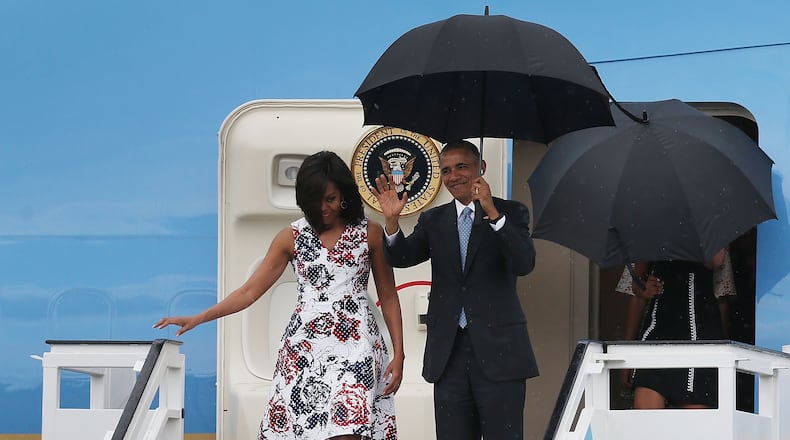- Texas mom accused of putting 2-year-old daughter in oven
- Hikers discover human skull near Hollywood sign in LA
- Couple rebuilding family after losing 7 kids in fire, welcomes child No. 13
- Memphis police officer fights with teen resisting arrest
- Sticky situation? NBA investigating after Dwight Howard caught using stickum
Air Force One landed in Cuba Sunday, marking the beginning of President Barack Obama's historic three-day visit to the island nation. The trip comes two years after Obama and Cuban President Raul Castro announced a thawing of diplomatic relations between the former Cold War-era rivals.
Here are some things to know about the visit:
Trip aimed at engaging the Cuban people
Carrying umbrellas, Obama, his wife Michelle and his daughters, Sasha and Malia, walked the cobbled streets of Old Havana Sunday.
Obama made the first public remarks of his trip during a meet-and-greet at the recently re-opened U.S. Embassy in Havana.
He focused on his hopes for the visit, that “young American children, young Cuban children, by the time they're adults... think it's natural that a U.S. president should be visiting Cuba.”
“This is a historic opportunity to engage directly with the Cuban people and to forge new agreements and commercial deals, to build new ties between our two peoples and for me to lay out my vision for a future that's brighter than our past,” he said.
Obama becomes second sitting president to visit Cuba
When Air Force One touched down at Havana's Jose Marti International Airport Sunday afternoon, Obama became the second sitting president in history to visit Cuba.
It's been nearly 100 years since President Calvin Coolidge boarded the USS Texas and headed for the 1928 Pan-American Conference in Havana.
“Calvin Coolidge traveled (to Cuba) on a battleship, so the optic will be quite different from the get-go here,” said Deputy National Security advisor Ben Rhodes in a press briefing in February.
According to a New York Times account of his arrival, Coolidge was welcomed with a shower of roses as Cubans lined the shores and streets to catch a glimpse of the president.
"It took him three days to get here," Obama joked on Sunday. "It only took me three hours."
President to meet with Castro, civil rights activists and dissidents
During his trip, which is scheduled to last until March 22, Obama plans to spend hours with Castro, address the Cuban people and speak with civil leaders and dissidents.
The White House released the following schedule for the remainder of Obama's trip:
Monday:
- One-on-one meeting with Castro, 11:30 a.m.
- Expanded meeting with Castro, 1 p.m.
- Obama and Castro to address the press, 1:50 a.m.
- Entrepreneurship summit at La Cerveceria, 3:45 p.m.
- State dinner at the Palace of the Revolution, 7:30 p.m.
Tuesday:
- Meeting with civil rights activists and dissidents
- Address Cuban people at Alicia Alonso Grand Theater
- Baseball game between the Tampa Bay Rays and the Cuban National Team at Estadio Latanamericano, 2 p.m.
- Departure from Jose Marti International Airport
Days before trip, White House announces changes to Cuba sanctions
Just days before Obama's visit, the White House announced various changes to decades-old sanctions which affected trade with and travel to Cuba.
Among the changes, the U.S. Department of State and Transportation said it would allow for up to 110 non-stop flights between the U.S. and Cuba daily.
CDC issues travel advisory about Zika in Cuba
One day before Obama arrived in Cuba, the Centers for Disease Control and Prevention added the country to its list of those at particular risk for the Zika virus. The virus has been associated with an increase in cases of microcephaly, a birth defect that affects brain development and is hallmarked by a newborn's unusually small head size.
In February, the World Health Organization declared Zika an international public health emergency.
There is currently no vaccine for the virus.
About the Author
The Latest
Featured

